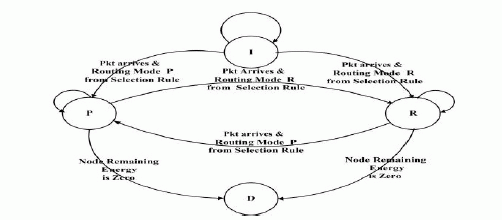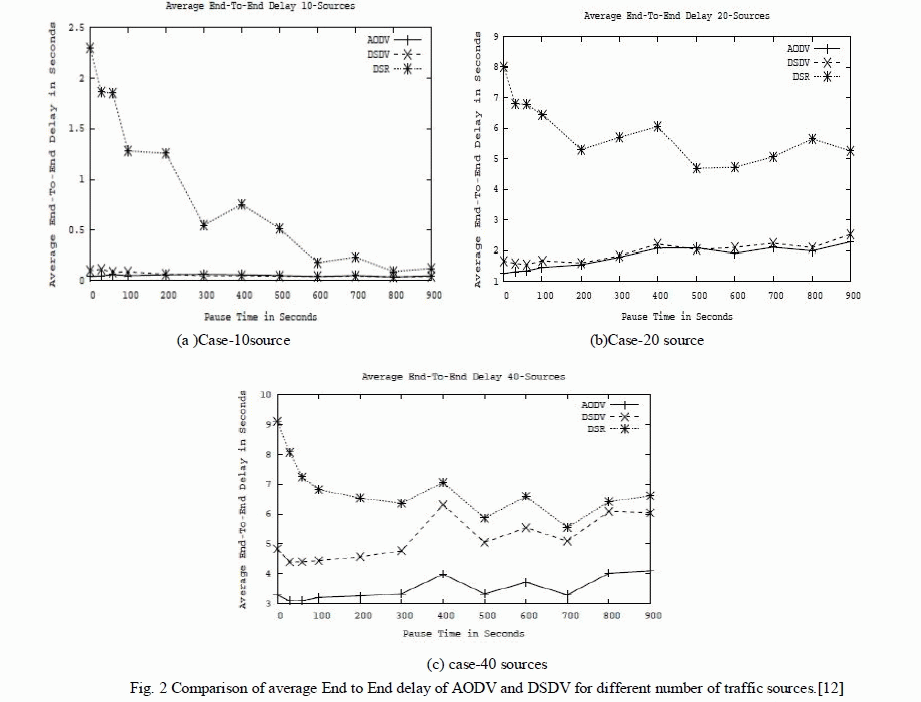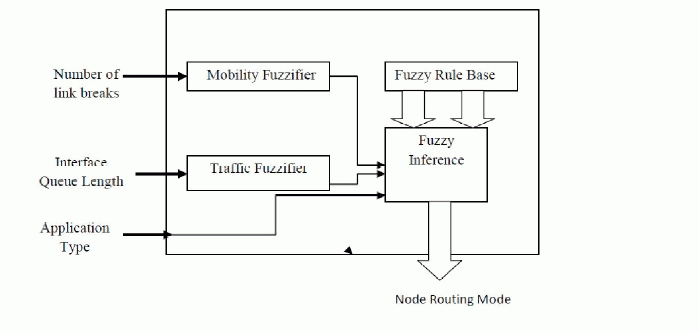Keywords
|
| Mobile Ad hoc Network (MANETs), Adaptive Routing, Cross-Layer Design, Fuzzy Logic. |
INTRODUCTION
|
| A Mobile ad hoc network are self created and self organized by a collection of mobile nodes which are interconnected by wireless link able to dynamically form an autonomous multi- hop network, without use of any fixed infrastructure or centralized administration. Ad hoc networks are attractive to a variety of applications due to their self forming nature and the ability to cope with rapid topology changes. Due to the antenna’s limited transmission range, the nodes in the network may act as router to forward packets to other nodes, and thus a routing protocol is needed. |
| The MANET routing protocol are classified into Proactive routing protocol and Reactive routing protocol. In proactive routing protocol, the nodes in the network maintains route to all possible destinations so it can be immediately used to forward packets to other nodes. DSDV (Destination Sequenced Distance Vector) [1] is an example for this category. On the other hand, reactive routing protocol discovers route to destination only when it is needed that is according to the demand. AODV (Ad hoc On demand Distance Vector) [2] is an example for this category. Another emerging approach is the Cross Layer Approach. The cross layer design is to support flexible layer approach in MANETs. It improves the performance of all layers and share information between the layers to obtain the highest possible adaptivity of any network. |
| In this paper, introduction section is followed by related previous works in section II. In section III which is continued by proposed solution and conclusion in section IV and V. |
RELATED WORKS/SURVEY
|
| In this section, a review of related works closed to the proposed routing protocol is presented. |
| Saida Ziane et.al, 2010 [3] proposes a new delay- oriented adaptive routing protocol called Adaptive Mean Delay Routing (AMDR) to estimate mean delay instead of instantaneous delay to achieve better performance. It is based on reinforcement learning mechanism. AMDR built on two modules: Delay Estimation Module (DEM) and Adaptive Routing Module (ARM) and it use two kinds of exploration agents: Forward Exploration Packets (FEP) and Backward Exploration Packets (BEP). FEP gather delay information of available path and it is utilized by BEP to update probabilistic routing table entries throughout the network. |
| Cong Liu et.al, 2008 [4] explained a routing scheme called Adaptive Routing Protocol in Dynamic Ad hoc Network (AROD),which is a seamless integration of several existing scheme. It demonstrates the feasibility of an adaptive approach to network density as well as node mobility. |
| B. Ramachandran et. al,2007 [5] they proposes a mobility adaptive cross layer design to enhance the performance of ad-hoc on-demand distance vector routing protocol by establishing stable routes. A decision is made to drop the Route Request (RREQ) or to forward it is based on the speed of the mobile nodes and the received signal strength. Comparing with the basic AODV routing protocol, the proposed cross layer algorithm has better performance. |
| Liang Qin et. al,2006 [6] discussed about the impact of mobility on the performance of routing protocols in MANET and showed that the individual nodes experience different mobility levels in terms of node degree, link duration, and number of link breaks. Among the three mobility level, link break is considered as the mobility metric because it is directly related to mobility ,simple and does not requires any extra control message but in node degree it react differently in scenarios with different node densities. Hence the number of link breaks observed by a node can adjust its routing behavior based on the network conditions thus routing protocol performance will be improved. |
| Cholatip Yawut et. al,2008 [7] comes with a Cross-layer mechanism, which enhance the mobile network performance by using the information issued in other layers. Some of those mechanisms are based on mobility metrics. The establishment of a route by choosing less mobile nodes could improve the routing protocol. They study the behavior of different mobility metrics to reflect the mobility influence over the protocol performances. A good mobility should be computable in distributed way without global network knowledge, predicts the protocol performance, easy to compute . The proposed approach evaluates the ability of a metric from its capacity to indicate or predict the routing protocol performance. The studied mobility metrics are Frequency of Link State Changes (LC), Link Connectivity Duration (LD) and Link Stability Metric (LS). |
| Pradeep Marchala et.al , 2008 [8] propose an on demand delay based quality of service (Qos) routing protocol (AODV-D) to ensure that delay does not exceed a maximum value for mobile ad hoc networks. This protocol discovered the routes based on path delay in addition to hop count instead of hop count only and its route maintenance is more efficient . The proposed protocol finds alternate routes in advance of congestion to maintain the QoS constraints throughout the network. For delay sensitive applications such as voice and video, it is necessary to provide quality delivery and it is extremely important that mobile ad hoc networks provide quality of service (QoS) in terms of delay and bandwidth . Most of the existing routing protocols for mobile ad hoc networks are designed to search for the shortest path with minimum hop count. Especially when there are congested nodes along the routes, then the shortest routes do not always provide the best performances. |
| Amina Akther et.al, 2006 [9] discusses about the dynamic characteristics of Mobile ad hoc network, has made it quite challenging to maintain connectivity and ensure Quality of Service (QoS).To provide quality of service (QoS) an enhanced protocol is proposed it is called NQoS AODV. Here, AODV- a purely on demand MANET routing protocol is enhanced to provide QoS. The control packets of AODV are modified to exchange the quality of service information among nodes and the information such as maximum delay, minimum available bandwidth are stored in its routing table. Any violation of Qos is experienced by intermediate node in the network and it generates ICMP QOS- LOST message. |
| C.Gomathy et.al,2005 [10] designed a Fuzzy based priority scheduler to determine the priority of packets and it is studied with multicast routing protocols. It is evaluated in terms of the quantitative metric such as packet delivery ratio and average end-to-end delay. Due to the mobility is unlimited, the failures are frequent such problem increase the delays and decrease the throughput. A scheduler can be used to overcome these challenges, to provide QoS and to improve the network performance. |
| Cherine Fathy et.al,2012 [11] proposed an adaptive cross layer routing protocol that can switch the routing mode of a node between proactive routing and reactive routing according to the current status of the node. Nodes current status information consist of mobility, network traffic load and application type (Delay sensitive or Delay tolerant).The route mode selector uses this information to change the routing mode of current node according to the transition diagram in Fig.1. |
| From the extensive simulation, comparing AODV and DSDV in terms of average end to end delay for different number of Active Traffic Sources and its result is the basis for the switching between routing modes in proposed protocol.Here the application is considered as delay sensitive , so the routing mode selected is the one that gives lower average end to end delay. |
| The above table shows the delay sensitive fuzzy rules from the above graphs, where R:Reactive Mode P: Proactive mode, LT: Low Traffic, MT: Moderate Traffic HT: High Traffic, LM: Low Mobility, MM: Moderate Mobility, HM: High Mobility, VHM: Very High Mobility . |
| In order to get the complete knowledge about mobility and traffic load in the network fuzzy rules has been incorporated into Routing Mode Selector. The system consist of four blocks, they are Traffic Fuzzifier ,Mobility Fuzzifier, Inference Engine and Fuzzy Rule Base. The three inputs to the Route Mode Selector are number of link breaks per second (LB), Interface Queue Length (IFQL) and application type and single output as shown in fig (3). |
| Using NS2 package, the authors applied the cross layer ideas to switch the routing mode in each node based on the mobility and traffic condition to the proposed Fuzzy -based Adaptive Cross Layer Routing Protocol. Mobility, Traffic load and Application type information are used for adaptation. It outperforms AODV, DSDV and other conventional routing protocol in terms of packet Delivery Ratio (PDR), End-to-End Delay (ETED) and Route discovery latency, but it requires higher number of control packet, So energy consumption will be high. |
PROPOSED SOLUTION
|
| The issues due to higher number of control packets have to be effectively dealt with in order to improve network performance. The key to simultaneously address this issue is to reduce the number of control packets. In order to reduce the number of control packets a backbone network [13] is proposed to get the destination location and thus the search area can be limited to zones. A mobile backbone network consists of backbone network, acess network, and regular Ad hoc Network. Here node uses 2 frequency one for regular ad hoc network and other for back bone network. The backbone network frequency is the highest frequency and it has large coverage range. Due to the high energy consumption only particular nodes use backbone network frequency. |
| Two types of mobile nodes are existing, they are high capacity nodes and low capacity nodes .High capacity nodes are considered as back bone nodes and low capacity nodes are considered as regular nodes. A backbone network is used to get the destination location and thus the searching area can be limited to zones .To limit the zone, the data route creation packets are transmitted to nodes have to know the destination location, when source needs a destination location, it broadcasts a request to corresponding backbone nodes in the backbone network. The backbone node in the backbone network find the destination in its associated nodes list , it ask the destination to send its location to source. In a network two types of source and destination exist, source may be regular or backbone node and similarly in case of destination also . If a regular node is source , then it sends a location request (Lreq) to corresponding backbone node and backbone nodes keeps in its location routing table. If the destination associated with its backbone node, it does not broadcast the request and it sends towards destination. Then destination sends a location response (L Rep) packet to source via backbone that have forwarded LReq and thus it limits search area and can reduce control packets. |
CONCLUSION
|
| In this paper, we have done a thorough survey on the works done by various researchers on different routing protocols and different metric used in the Mobile Ad hoc Network. The main limitation of the conventional routing protocol and modified routing protocol is that they do not react instantaneously to the changes in the mobility and traffic conditions. Hence the efficiency of network is reduced. In order to solve this problem, a new routing protocol called Fuzzy- based Adaptive Cross Layer Routing Protocol is introduced. It has the ability to switch the routing mode between proactive routing mode and reactive routing mode based on the current status of the node. It outperforms AODV,DSDV and other conventional and modified protocol in terms of Packet Delivery Ratio, End to End Delay and Route discovery latency, but it requires higher number of control packets, so energy and bandwidth consumption will be high. In order to overcome the energy and bandwidth constraints, it is necessary to reduce control packets used in the network. So a backbone network is proposed to get the destination location and thus the search area can be limited to zones. This significantly reduces the number of control packets and obtain energy and bandwidth efficiency. |
ACKNOWLEDGMENT
|
| The ongoing related work based on the suggested solutions could not have been possible without Mr. George M. Jacob, Lab Instructor, Toc H Institute of Science and Technology who have encouraged us throughout to address the problem. We thank him for his constant help and support. |
Tables at a glance
|
 |
| Table 1 |
|
| |
Figures at a glance
|
 |
 |
 |
| Figure 1 |
Figure 2 |
Figure 3 |
|
| |
References
|
- C. Perkins and P. Bhagwat, “Highly Dynamic ( DSDV ) for Mobile Computers Routing,” SIGCOMM ComputCommun. Rev, vol. 24, no. 4,pp.234–244, 1994.
- C. Perkins, E. Belding-Royer, and S. Das, “Ad hoc on- Demand DistanceVector (AODV) Routing,” RFC 3561, pp. 1–37, july 2003.
- SaidaZiane and A. Mellouk “Inductive Routing based on Dynamic End -to-End Delay for Mobile Networks,”GLOBAL COMMUNICATIONS CONFERENCE (GLOBECOM 2010), Maimi, Florida, USA, pp. 1-5, December 2010.
- C. Liu and J. Wu, “Adaptive Routing in Dynamic Ad Hoc Networks,”in IEEE Wireless Communications and Networking Conference, WCNC2008, Las Vegas, NV, USA, pp. 2603–2608, 31 March - 3 April 2008.
- B.Ramachandran and S. Shanmugavel, “Mobility Adaptive Cross Layer Design for Reliable Route Discovery in Ad-hoc Networks,” in IEEE International Conference on Wireless Communication and Sensor Networks,WCSN’07.,Allahabad,India ,pp. 69–73 Dec 2007.
- L.Qin and T. Kunz, “Mobility Metrics to Enable Adaptive Routing in MANET,” in 2nd IEEE International Conference on Wireless and MobileComputing,Networkingandcommunications,(WiMob’2006), Montreal, Que, Canada, pp. 1–8, 19-21 June 2006.
- C. Yawut, B. Paillassa, and R. Dhaou, “Mobility Metrics Evaluation for Self-Adaptive Protocols,” Journal of Networks, vol. 3, no. 1, pp. 53– 64, Jan. 2008.
- P. Macharla, R. Kumar, A. Sarje, and M. Misra, “A QoS routing protocol for delay-sensitive applications in mobile ad hoc networks,” in 3rd International Conference on Communication Systems Software and Middleware and Workshops, COMSWARE 2008, Bangalore, India, pp.720– 727 , 5-10 January, 2008.
- A. Akhter and T. Sanguankotchakorn, “Modified AOD for multi constrained QoS routing and performance optimization in MANET,” in International Conference on Electrical Engineering/Electronics Computer Telecommunications and Information Technology (ECTI-CON), Chaing Mai, pp. 234–238 Thailand, 19-21 May, 2010.
- C.GomathyandS.Shanmugavel,“ Supporting QoS in MANET by a Fuzzy Priority Scheduler and Performance Analysis with Multicast Routing Protocol”in EURASIP Journal onWireless communications and Networking ,pp. 426–436,2005.
- CherineFathy, Mahmoud T. El-Hadidi, MohamadAbou El-Nasr, "Fuzzy-based adaptive cross layer routing protocol for mobile ad hoc
- networks,” IEEE international Performance Computingand communications Conference, 30th IEEE International Performance Computing and Communications Conference, pp. 1-10, 2011.
- Cherine Fathy, Mahmoud T. El-Hadidi,MohamadAbou El-Nasr, "Fuzzy-based adaptive cross layer routing protocol for delay sensitive applicationsinMANET," IEEE International Performance Computing and Communications Conference, pp. 1-6, 2012.
|